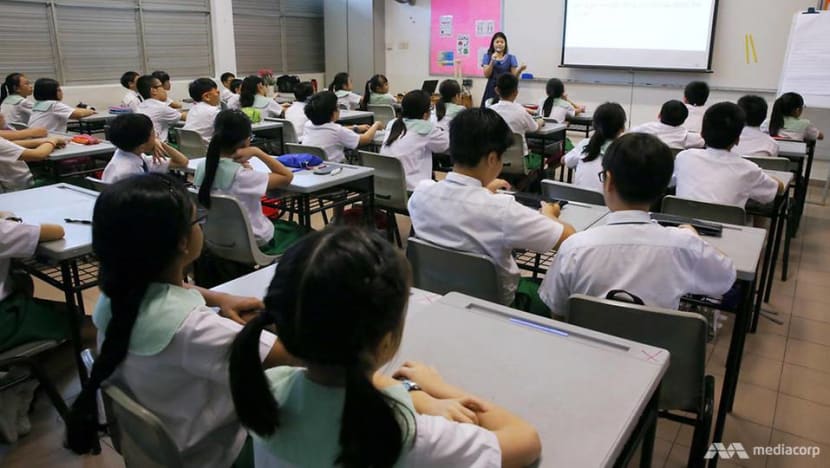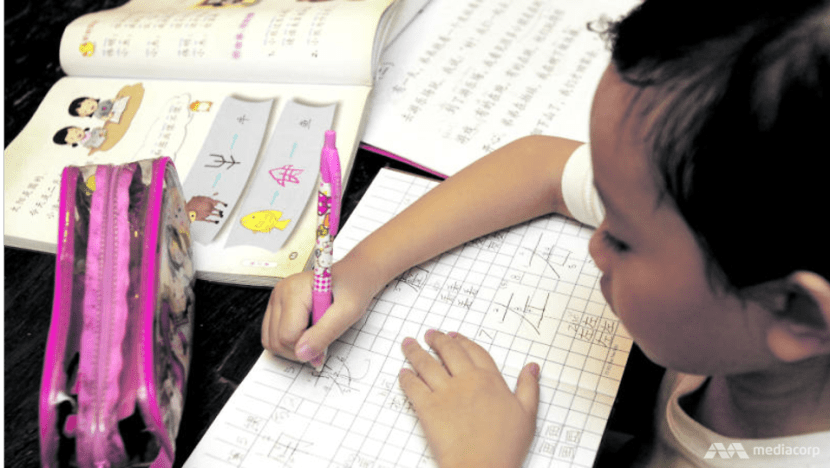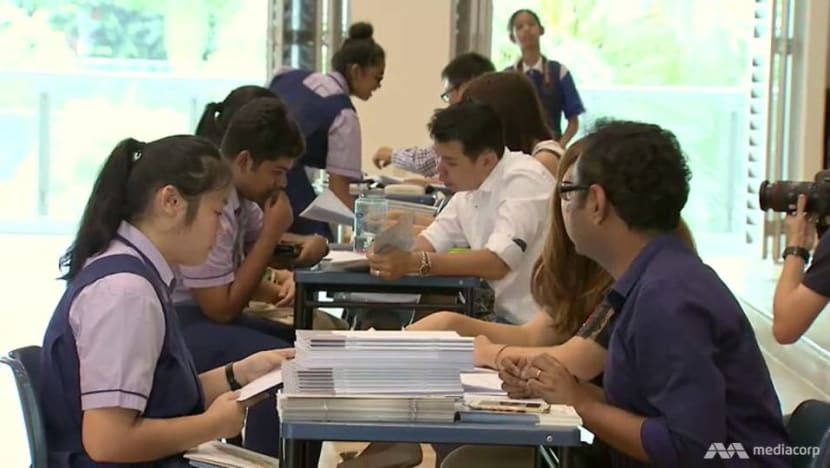commentary Commentary
Commentary: The trouble with helping disadvantaged kids is you don’t know where to start
With the odds stacked up against kids from low-income families, figuring out where to intervene can be tricky, says June Yong.

Students attending a class at a primary school. (File photo: TODAY)
SINGAPORE: Ben, aged 12, has been missing school for weeks. It is an important year and his teacher is concerned.
So Ben’s teacher decides to make a home visit.
Ben was shocked to see his teacher at his doorstep. He explained that he has to help his mum at the hawker centre till late at night and experiences difficulty waking up on time in the morning.
This is a common scenario facing children from disadvantaged backgrounds. When basic needs such as food, money, or a proper night’s sleep go unmet over a prolonged period, education falls off the priority ladder. Survival takes its place.
The Ministry of Education (MOE) recently announced the setting up of an inter-agency task force to tackle this problem. It is heartening to hear about the efforts involved to scrutinise the issues, but it also makes me wonder: With such systemic obstacles stacked against these kids, where do we even begin intervention?
READ: Trade-offs unavoidable in social policy: MSF
THE CAUSES BEHIND ABSENTEEISM
The issues of absenteeism and poor academic performance or attitude are understandably complex.
The obstacles that these children face include lack of food, having to work to help out with expenses, lack of money for transport or school supplies, and lack of peer support in school.
The issues they face in school may not go to the extent of bullying, but rather are those of disconnection. As they are unlikely to be able to afford a smartphone, or meet at Pasta Mania to discuss a project, they face a certain kind of exclusion that is both pervasive as it is profound.
When they struggle to fit in and feel poorly about themselves, they start to withdraw. After being absent for a period of time, they lose touch with their friends, and schoolwork takes on insurmountable proportions.
The downward spiral can be sure and forceful as gravity takes its toil.

READ: This is what the face of poverty looks like, a commentary
Once we look beyond the surface, it becomes apparent that identifying and fixing such a child’s financial and physical needs while important are insufficient in themselves.
The child at risk often suffers not merely from the obvious physical deprivation, but also an emotional one.
How do you handle a child who lacks the love, presence, and support of parents who may have to work many jobs to make ends meet or are incarcerated?
Without parental support in the home, it may take “surrogate parents” in the form of a student welfare officer, teacher, or even a neighbour who is willing to go the extra mile.
A friend who’s a teacher sacrificially shouldered that parenting role for a few students over different periods of time. He ferried them to school by public transport, bought food supplies when needed, offered teaching and discipline, and even worked with them to replace unproductive habits with healthier ones.
He has seen a couple of success stories. One student came in second in his cohort during Secondary 3 and finally completed his N-levels and moved on to the Institute of Technical Education.
The key, this model teacher says, is to understand their needs, earn their trust, and then walk with them towards better turn-up rates and performance in school.
Granted, not every teacher is willing to go to such lengths. But even small tweaks in our attitudes can reap benefits.
READ: Tackle inequality by moving from emotion to action, a commentary
PATIENCE AND EMPATHY REQUIRED
One teacher who has been examining issues surrounding poverty as part of his Teaching Certificate in International Baccalaureate shared some of his reflections.

He believes that he may have dealt with some youths from disadvantaged backgrounds in the past, and thinks there is room for teachers to show them kindness and empathy.
He explained: “Once we understand that these students lead very different lives and face multiple challenges, we have to communicate differently in order to establish trust and rapport."
If they fall asleep in class, or didn’t do their homework, we need to understand the reasons why and then take the appropriate steps to help them overcome the obstacles.
It is important to speak to them in private and to use an approach that is both firm and caring, he said, and to help them set small, manageable tasks, such as staying back for 15 minutes after school to tackle a portion of their homework.
He also suggested offering alternative methods to help students to keep up with lessons. For example, if the child has access to a computer at home, lesson notes or homework can be emailed to them.
Finally, if the child's behaviour needs to be addressed, teachers should suggest ways to improve and give reasons for it without using sarcasm.
"This puts the responsibility of change on the child without demeaning them," he said.
READ: Inequality has a geographic dimension - between and within neighbourhoods in Singapore, a commentary
COMMUNITY HELPS TO PLUG THE GAPS
Parents are yet another unpredictable factor in the complex equation of help for disadvantaged youths.
They may be weighed down with work, finances or relationship issues of their own, making it hard for them to bear the responsibility of supporting their child’s education.

Take for instance the single parent’s situation. Work usually takes up a big chunk of the parent's time and energy, not to mention mental space.
Parenting may then fall on the grandparent's shoulders or digital nannies.
While either option may not always work out perfectly, it is clear that such families need more practical help and less judgement or shame.
What may be more constructive is to brainstorm ways that the community – relatives, neighbours, or even the child’s peers – can chip in to help the child stay in school (during school hours), off the streets (during after-school hours), get some pocket money, and have access to textbooks and quality reading material.
Granted, most schools have some form of SOP for roping in social aid agencies to provide financial help to needy families. But there may be a gap before the funding gets approved and received by the families themselves.
This is where the community can play a role in plugging the gap.
PROCEED WITH CARE
Complex issues such as poverty and absenteeism involve many stakeholders, from teachers and student welfare officers, to counsellors, social work agencies, and the community.
It’s also an entire life cycle involving many intricate steps – from identification of an at-risk child, to understanding what their specific needs are, addressing those needs in a sustainable way, and providing a nurturing environment that is conducive for learning. One misstep and the child may drop out of school.
READ: Can education fix inequality in Singapore? If not, what can? A commentary
Any intervention strategy would do well to avoid the scenario of passing the child (or “case”) from one party to another, like hot potatoes.
Tempering the academic expectations for these students and helping them to set more realistic goals may enable them to experience a sense of control and confidence.
The turnaround story cited earlier may not be achievable for every at-risk student, but keeping them in school and off the streets is a good starting point for them to receive the help they need.
By the age of early adolescence (or 11 to 14 years), issues of identity, self-esteem and peer acceptance take centre stage, and we should also ensure that the child’s social-emotional needs are cared for.
Harsh methods such as punishment, guilt, or force will have to be thrown out the window. It will be next to impossible to arm-twist these youths to make good choices in life.
But by taking the time and patience to establish trust, respect, and rapport with the student, it may be possible to chip away at this seemingly insurmountable mountain, and conquer it – one careful step at a time.
June Yong is a mother of three, an educational therapist and owner of Mama Wear Papa Shirt, a blog that discusses parenting and education in Singapore.












